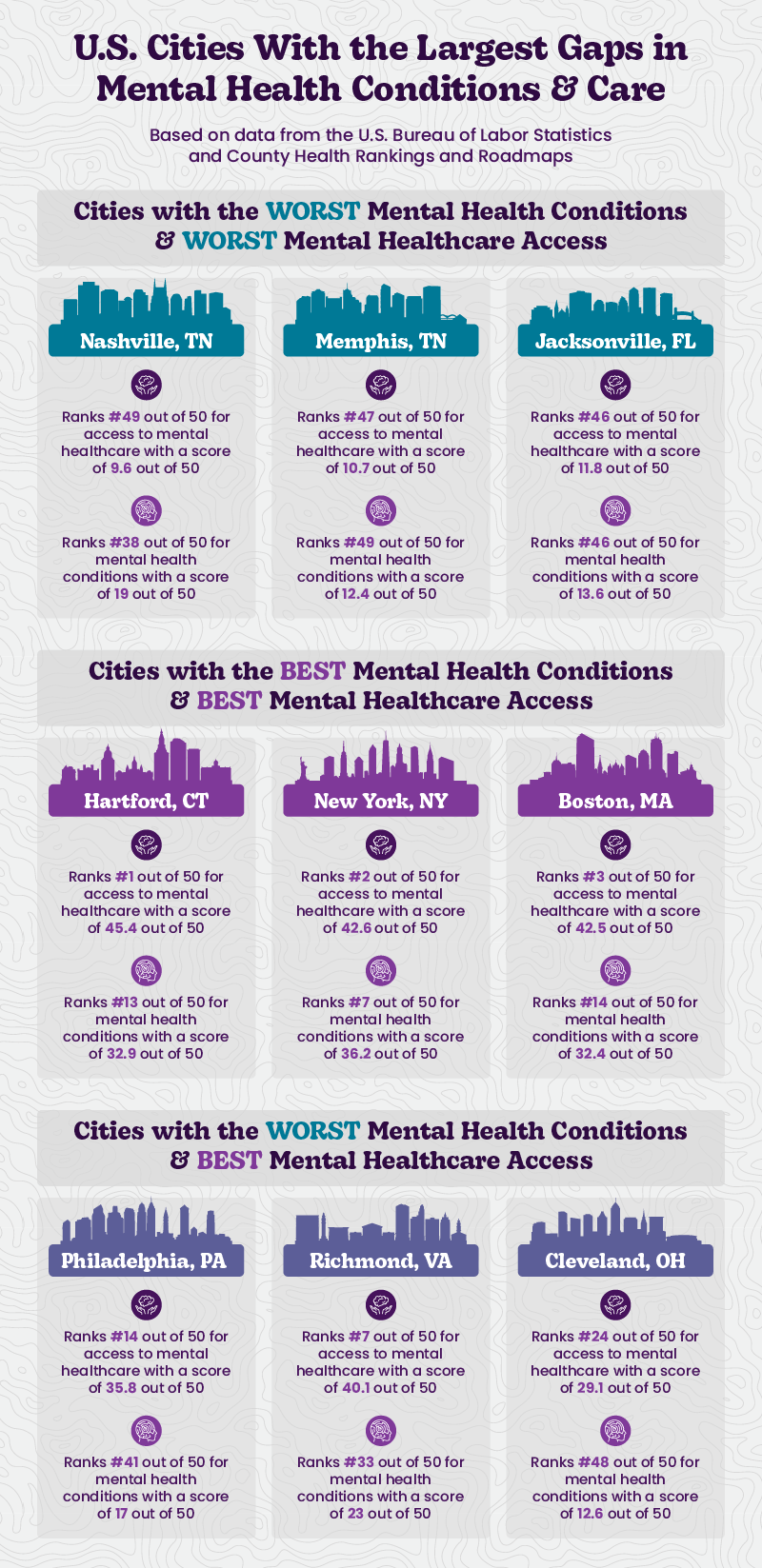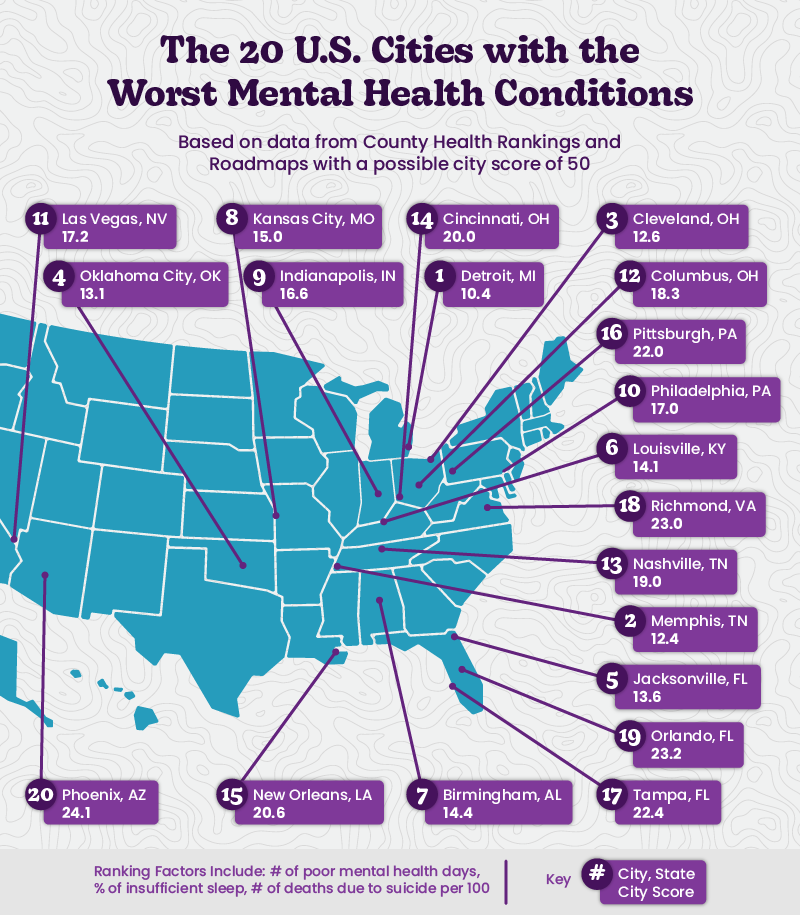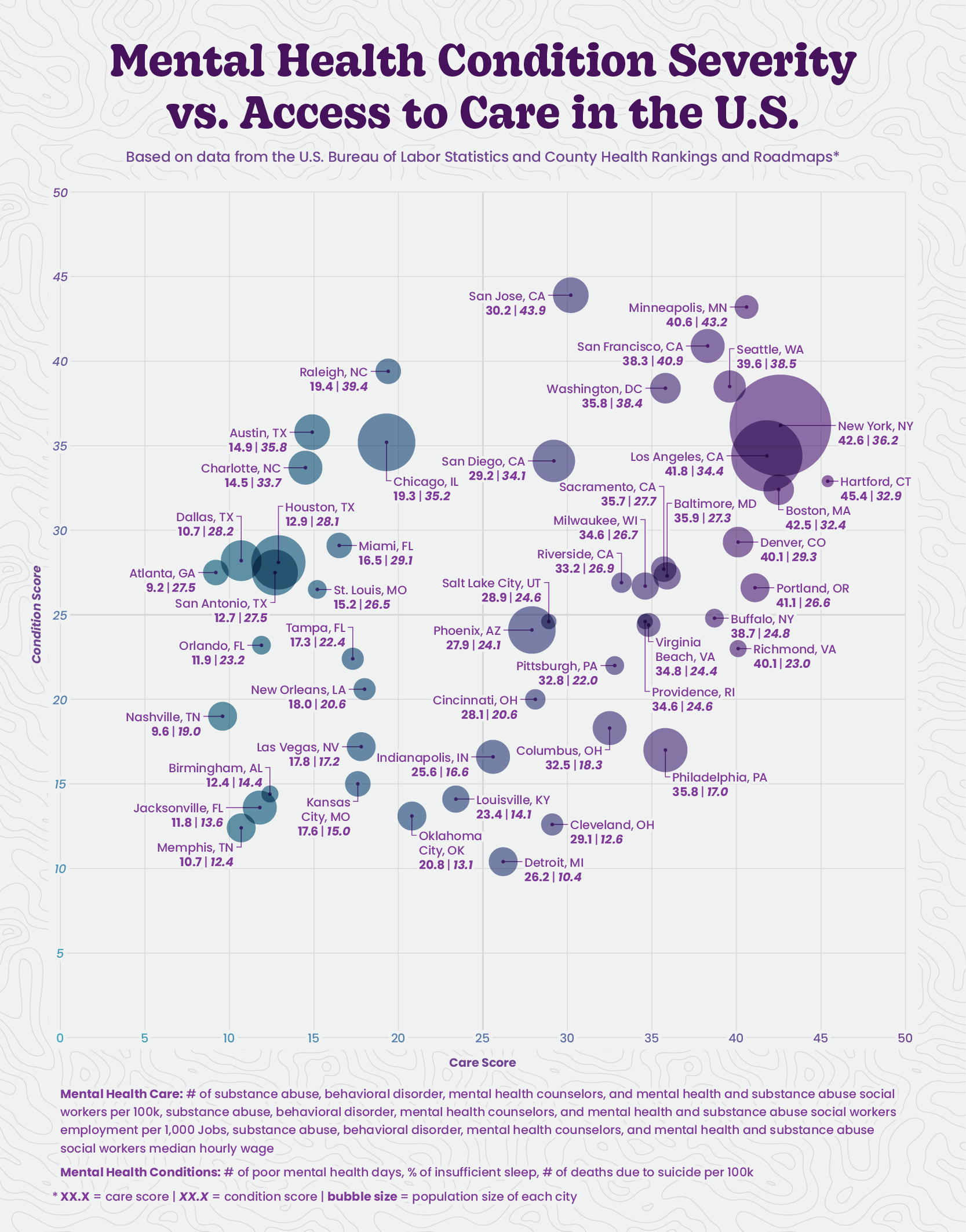An Analysis of Mental Health Disparities Across the U.S.

According to the National Institute of Mental Health, nearly one in five U.S. adults live with mental illness (57.8 million in 2021).1 Mental illness can affect your mood, thinking and behavior. It encapsulates a wide range of diagnoses, such as depression, anxiety, schizophrenia, addictive behaviors and eating disorders.2
Sadly, not everyone has access to mental health services, which in some severe cases could lead to depressive episodes or even suicide. With Americans spending more and more time online, some are using social media as a useful psychotherapy outlet to discuss their symptoms and learn more about therapy.3 Online conversations surrounding mental health continue to grow, with hashtags such as #MentalHealthMatters being viewed more than 13.5 billion times on TikTok.4
Increased social media use has often been connected to feelings of loneliness, anxiety and depression, but experts agree that talking about mental health struggles online and spreading awareness can be a great step in the right direction.4,5
To continue the conversation about mental health barriers and with the desire to destigmatize mental illness, Grand Canyon University (GCU), in partnership with Grand Canyon Education (GCE), analyzed 50 of the most populated U.S. cities and evaluated them on important factors related to mental health access and the overall mental health of the city.
Keep reading to discover which cities are focusing on the needs of their community and making mental health a priority!
Please note: If you or someone you know is in need of help in the U.S., please call the National Suicide Prevention Lifeline at 1-800-273-8255, call or text 988 or chat at 988Lifeline.org.
In This Mental Health Access Guide:
- Mental Health Access: Methodology
- Mental Health Disparities: The U.S. Cities With the Largest Gaps in Mental Health Conditions and Care
- Measuring Mental Health: The 20 U.S. Cities with the Worst Mental Health Conditions
- How Mental Health Access Impacts Mental Health Quality
- Closing Thoughts on Mental Health Access
Mental Health Access: Methodology
To highlight mental health disparities, we evaluated data in two main categories: access to mental healthcare and quality of mental health in the 50 most populous U.S. cities. To evaluate mental healthcare access, we used data from the U.S. Bureau of Labor Statistics.6 We evaluated three main factors.
- The number of substance abuse, behavioral disorder, mental health counselors and mental health and substance abuse social workers per 100K people
- Substance abuse, behavioral disorder, mental health counselors and mental health and substance abuse social workers employment per 1,000 jobs
- Substance abuse, behavioral disorder, mental health counselors and mental health and substance abuse social workers median hourly wage
Based on the ranges associated with each factor, we translated the raw data into a score on a scale from 0 to 5, with 5 indicating a city with more resources for those to get mental health care. Each factor score was weighted evenly. The final city score is based on the combination of each factor score multiplied by its weight for a possible total score of 50. A perfect score of 50 would indicate the best possible score for mental health care.
We replicated the same methodology when measuring mental health conditions, relying on data from County Health Rankings and Roadmaps.7 We evaluated the following factors:
- The average number of mentally unhealthy days reported in the past 30 days
- Percentage of adults who report fewer than seven hours of sleep on average
- The number of deaths due to suicide per 100K people
We then compared the scores of the care and conditions within cities to identify which have the strongest and weakest correlations.
Mental Health Disparities: The U.S. Cities With the Largest Gaps in Mental Health Conditions and Care

To determine the cities with the biggest mental health disparities, we looked at factors such as the number of mental health counselors per 100k people and the number of deaths due to suicide per 100k residents.
Falling to the bottom of our list of cities with the worst care and worst conditions is Nashville, Tennessee, which ranks second to last (49 out of 50) in access to mental health care and 38 out of 50 in mental health conditions. Residents reported a high number of poor mental health days (4.9) in the past 30 days and 13 suicides.
Renters in Music City saw a 32% year-over-year jump in the average cost of housing from May 2021 to May 2022.8 A cyclical relationship exists between money problems and mental health, with poor mental health resulting in difficulties managing finances, which exacerbates mental health.9 Among the mental health barriers are financial pressure and stress caused by not being able to pay for basic utilities, which could result in Nashville residents experiencing higher levels of poor mental health.
Following closely behind in cities that could benefit from added mental health care is Jacksonville, Florida, which ranked 46 out of 50 for both access to mental health care and mental health conditions. Jacksonville is home to less than one social worker job postings per 1,000 jobs.
Mental health disparities in northeastern Florida are mainly caused by health care access, poverty and chronic diseases such as cancer and diabetes, according to a study conducted by Jacksonville mental health experts.10
On the opposite end of the spectrum is Hartford, Connecticut, which ranks No. 1 when it comes to access to mental health care and places 13 out of 50 for mental health conditions.
Nonprofits in Hartford are stepping up in the wake of the pandemic, which left many students with increased feelings of anxiety and depression, by hiring more therapists.11 This has increased their ability to see more patients through renovations and partnering with school districts to give students direct access to care.11
We also found that high healthcare scores do not always mean high condition scores. Despite ranking 14 out of 50 for access to care, Philadelphia, Pennsylvania, still places 41 out of 50 for mental health conditions. This means that a city like Philadelphia can have a high number of mental health counselors and resources but can still be suffering greatly from poor mental health, including poor mental health days and suicide, proving there is not always a positive correlation between the two.
Crises like the opioid epidemic, which is affecting major cities like Philadelphia, can be one reason why the city scores poorly for mental health conditions.12 Those suffering from mental disorders might attempt to self-medicate with substances, but it typically worsens their symptoms.13
Measuring Mental Health: The 20 U.S. Cities with the Worst Mental Health Conditions

When it comes to measuring mental health, we looked at factors like the average number of mentally unhealthy days reported in the past 30 days, the number of suicides per 100,000 people, and the percentage of adults who report fewer than seven hours of sleep on average to determine which cities had the worst mental health conditions overall.7
Placing at the top of our list of cities with the worst mental health conditions is Detroit, Michigan, which received a city score of 10.4 out of 50. We found that Wayne County, where Detroit is located, had a total of 5.4 poor mental health days (the average number of mentally unhealthy days) reported in the past 30 days and 12 suicides per 100,000 residents.14,15,16 Detroit has the second-highest violent crime rate in 2023, which could be a contributing factor to mental health struggles.17
Close behind on our list is Memphis, Tennessee, with a city score of 12.4 out of 50. Memphis is located in Shelby County which has the highest percentage of adults who report fewer than 7 hours of sleep on average at 46%.18 Sleep plays a vital role when measuring mental health, as getting sufficient sleep can help your brain to retain positive thoughts and memories, while poor sleep can harm your mood and mental well-being.19 In addition, the state of Tennessee only has 16.3% of the psychiatrists it needs, which continues to create mental health barriers for its residents.20
Cleveland, Ohio, came in third with a score of 12.6 out of 50. According to World Population Review, Cleveland has one of the highest poverty rates across U.S. cities.21 There appears to be a causal connection between poverty and mental health, whereby poverty can trigger mental health and developmental problems, thus hindering individuals from escaping poverty and perpetuating a cycle of deprivation.22
How Mental Health Access Impacts Mental Health Quality
To illustrate how mental health access is impacting the quality of mental health, we examined 50 of the most populous cities and plotted each city’s condition and care score on our infographic below. The mental health conditions ranking was formulated by looking at factors, such as the number of poor mental health days and suicides in the county of each city analyzed, while the mental healthcare score is representative of factors like the number of counselor and social work openings per 1,000 job posts and the median hourly wage of social workers.6, 7 Each city can attain a possible total score of 50 for each category. Lower scores indicate substandard mental health outcomes.

Places like Dallas, Texas, received a low mental healthcare score of 10.7 out of 50 and a below-average mental health condition score of 28.2 out of 50. One study showed that those in Dallas may be suffering from high levels of burnout due to factors like working longer hours during the workweek, which could contribute to higher levels of stress, depression and anxiety.23 In addition to this, having limited resources for mental healthcare can make navigating daily life more challenging.
The Big Apple, a.k.a., New York, New York, received a strong mental health care score of 42.6 and a mental health condition score of 36.2. New York’s mental health crisis has continued to worsen with the pandemic exacerbating an already bleak situation, including a lack of in-patient psychiatric beds and growing levels of homelessness.24
It’s clear from our findings that mental health challenges and mental health access are fundamentally linked. If you’re suffering from poor mental health and need help or want to take a preemptive approach to ensure your mental health remains strong, learning what resources are available in your city can be very beneficial.
Locate your city above to see if there is a correlation between mental health access and mental health quality in your city!
Closing Thoughts on Mental Health Access
While we can’t always predict what life will throw at us, especially as busy college students under the stress of completing homework, keeping up with classes and applying to jobs, we can take small steps to manage our mental health and talk to a therapist when needed. In fact, nearly 88% of students reported their school life was stressful, according to American Addiction Centers.25
At GCU, we offer a range of student care and support options, including workshops, crisis services, supportive parenting tips and tools and even a health and wellness clinic for on-campus students. We also offer counseling and psychology degree programs for those who are passionate about pursuing a career in helping others.
Access to mental health resources can be a critical lifeline for individuals in crisis, providing confidential support and connecting you with trained professionals who can offer assistance and support during times of distress. If you or someone you know is in need of help in the U.S., you can call the National Suicide Prevention Lifeline at 1-800-273-8255, call or text 988 or chat at 988Lifeline.org.
1 National Institute of Mental Illness, Mental Illness in February 2023
2 Mayo Clinic, Mental Illness in February 2023
3 Psychology Today, The Rise of Social-Media Psychotherapy in February 2023
4 NBC News, TikTok has new mental health resources for its users. Some experts say it's a good start in February 2023
5 Penn Medicine Lancaster General Health, The Effects of Social Media on Mental Health in February 2023
6 Bureau of Labor Statistics, Occupational Employment and Wage Statistics in February 2023
7 County Health Rankings, Explore Health Rankings in February 2023
8 Redfin, Rental Market Tracker: Typical U.S. Asking Rent Surpassed $2,000 For First Time In May in February 2023
9 Money and Mental Health, Money and Mental Health: The Facts in February 2023
10 News4 JAX, UF Health Jacksonville exec says mental health access is North Florida’s top issue in February 2023
11 CT Insider, How West Hartford is handling rising youth mental health cases in February 2023
12 City of Philadelphia, Combating the opioid epidemic in February 2023
13 National Institute on Drug Abuse, Substance Use and Co-Occurring Mental Disorders in February 2023
14 County Health Rankings Model, Michigan Data by County Poor Mental Health Days in February 2023
15 County Health Rankings Model, Michigan Data by County Suicides in February 2023
16 County Health Rankings and Roadmap, Poor Mental Health Days in March 2025
17 World Population Review, Most Violent Cities in America 2023 in February 2023
18 County Health Rankings Model, Tennessee Data by County Insufficient Sleep in February 2023
19 Sleep Foundation, Mental Health and Sleep in February 2023
20 Action News 5, Mental Health Care Health Professional Shortage Areas (HPSAs) in March 2023
21 World Population Review, Poorest Cities in America 2023 in February 2023
22 PsychCentral, The Vicious Cycle of Poverty and Mental Health in March 2023
23 Fort Worth Inc., Fort Worth Ranks Sixth Among Cities Where Worker Burnout is Most Likely, Study Says in February 2023
24 Spectrum News, Losing hope on the streets: A mental health crisis grips the city in February 2023
25 American Addiction Centers, School Stress for College Students and Unhealthy Coping Mechanisms in March 2023
Approved by the Executive Director of Communications and Public Relations on April 10, 2023.
The views and opinions expressed in this article are those of the author’s and do not necessarily reflect the official policy or position of Grand Canyon University. Any sources cited were accurate as of the publish date.


